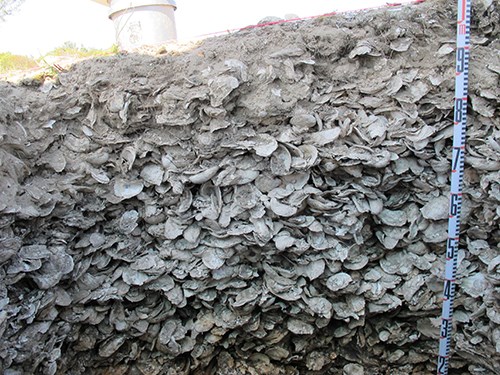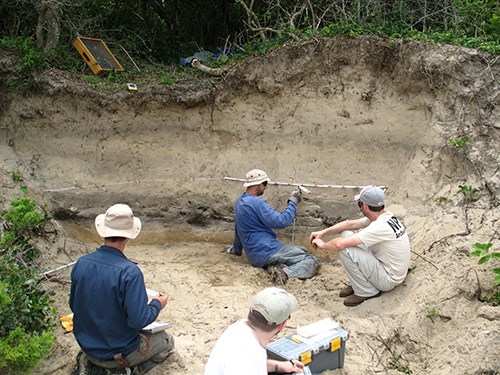Last updated: September 3, 2019
Article
2012 Cape Lookout National Seashore (CALO) Excavations

NPS
Since 2012, SEAC has been conducting excavations at Cape Lookout National Seashore (CALO) as part of a currently planned 5-year project aimed at salvaging what remains of archeological sites that are now threatened by rapid shoreline erosion, which is a consequence of rising sea levels associated with global climate change. In some areas of the park the rate of shoreline loss has been shown to be as rapid as 2-5 feet per year on average.
So far these investigations have consisted of limited testing of prehistoric shell midden deposits that have been radiocarbon dated as early as 700-600 B.C. and is among the earliest known prehistoric occupations on the North Carolina outer banks. Preliminary analysis of the prehistoric sites tested so far has shown harvesting of clams, oysters and other shellfish was a primary activity on the islands of CALO. Pottery styles associated with the shellfish remains are primarily grog-tempered and sand-tempered Mount Pleasant types dating to the Middle Woodland (A.D.300 - 800) and Late Woodland (A.D. 800 - 1650) periods.
Several late 18th and early 19th century house sites associated with the maritime oriented community known as Diamond City have also been tested. One of these was found buried beneath high sand dunes, which has resulted in excellent preservation of the faunal remains left behind by its circa 1780-1820 occupants. The pottery collected from the site shows a reliance on ceramic wares imported from England to provide the household’s tablewares and storage vessels. Preliminary analysis of the faunal remains at this site indicates a wide breadth approach to providing the inhabitants’ dietary needs that included the consumption of naturally available marine resources such as turtles, fish, scallops, oysters, clams, and whelks, raised livestock including cattle and swine, as well as hunting of shore birds, deer, raccoon, and opossum.
In addition to conducting the very first research-oriented archeological excavations that have ever been undertaken at CALO, the project is funding a geological study with Dr. Stanley Riggs of East Carolina University in order to provide a better understand of the history of environmental changes that have occurred on the barrier islands during the period of some 2500 or more years in which human habitation has occurred on these dynamic and rapidly changing land forms. Another aspect of the CALO archeological project that represents a first of its kind in the Outer Banks is a study of modern clam shell growth patterns, that, when completed, can be used as a basis for determining what seasons of the year clams were being harvested at both prehistoric and historic sites in the past.

NPS

NPS
